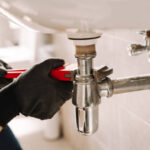How to Fix a Leaking Copper Pipe: 8 Proven Methods for Quick & Effective Repairs
Water leaks are one of the most frustrating issues homeowners face—especially when they come from copper pipes. Whether it’s a small pinhole or a large rupture, a leaking pipe can cause major damage if left untreated.
In this guide, you’ll discover how to repair copper pipe leaks quickly, affordably, and with minimal tools. We’ll cover both temporary fixes and permanent solutions—including beginner-friendly options and code-approved repair methods.
⚠️ Important: Always turn off your home’s main water supply before attempting any pipe repairs. If the leak is near electrical wiring or difficult to reach, it’s best to call a licensed plumber.
Why You Should Act Fast on Copper Pipe Leaks
Even a small leak in your copper plumbing can lead to:
- Mold and mildew growth
- Structural water damage
- Increased utility bills
- Risk of flooding
If you notice water spots, dripping, or hissing sounds, locate the leak as soon as possible and determine whether it’s a minor issue or a sign of system-wide failure.
💡 Homeowners in the Atlanta area, especially those using water from the Cobb County-Marietta Water Authority, often experience pinhole leaks due to aging copper pipes. If this is your case, consider a professional inspection or a whole-house repipe.
8 Methods for Repairing Copper Pipe Leaks
Here are the top repair methods—ranked by durability, skill level required, and whether they’re up to building code.
1. Soldering Two Couplings & a New Pipe Section (Permanent / Code Approved)
This is the most durable and professional-grade method.
How to Do It:
- Turn off the water supply.
- Mark and cut out the damaged pipe section using a pipe cutter.
- Measure and cut a new copper pipe to fit.
- Deburr the edges with a utility knife (inside) and file (outside).
- Slide slip couplings over the original pipe ends.
- Insert the new pipe piece and align the couplings.
- Solder the joints and wipe off excess flux.
- Let cool and test for leaks.
✅ Pros:
- Long-lasting and code compliant
- Inexpensive for DIYers with soldering experience
⚠️ Cons:
- Requires soldering tools and skills
- Not beginner-friendly
2. Compression Couplings (Permanent / Code Approved)
Ideal for DIYers who want a no-solder solution.
How to Do It:
- Cut out the damaged section.
- Slide a retainer nut and sleeve onto each end of the new pipe.
- Apply pipe dope to the sleeve.
- Tighten retainer nuts with a wrench to secure both sides.
✅ Pros:
- Easy to install
- Code-approved and durable
⚠️ Cons:
- May leak if not tightened properly
- Slightly more expensive than soldering
3. SharkBite Slip Coupling (Permanent / Code Approved If Installed Properly)
A fast and easy push-to-connect option that doesn’t require tools beyond a cutter.
How to Do It:
- Cut and deburr the pipe.
- Slide the fitting onto one side of the pipe.
- Use a wrench or push tool to slide the fitting over the other side.
✅ Pros:
- No soldering needed
- Great for tight spaces
⚠️ Cons:
- Sensitive to sunlight
- Must be installed precisely
4. Repair Clamp (Temporary / Not Code Approved)
Quick fix for a single hole if you need to stop the leak immediately.
How to Do It:
- Match the clamp size to your pipe.
- Position the rubber gasket over the hole.
- Clamp it tightly in place.
✅ Pros:
- Extremely easy
- Works for emergencies
⚠️ Cons:
- Temporary only
- Not suitable for long-term use
5. Soldering a Hole Shut (Temporary / Not Code Approved)
Can work on a very small, singular leak (like the size of a pencil tip).
How to Do It:
- Clean the pipe.
- Apply flux and heat it with a blow torch.
- Add solder to seal the hole.
✅ Pros:
- May allow temporary use of water
⚠️ Cons:
- Often ineffective
- Not reliable for pinhole leaks
- Should only be used while waiting for proper repair
6. Copper Wire Patch (Temporary / Not Code Approved)
A makeshift fix that’s similar to soldering but involves wire.
How to Do It:
- Clean the area.
- Wrap copper wire tightly around the leak.
- Solder the wire in place.
✅ Pros:
- May hold until plumber arrives
⚠️ Cons:
- Not reliable
- Only for small holes
- Requires soldering
7. Self-Fusing Silicone Tape (Alfa Tape) (Very Temporary / Not Code Approved)
This is like using duct tape for pipes—quick but short-lived.
How to Do It:
- Stretch the tape tightly around the leak.
- Overlap each layer to create a seal.
✅ Pros:
- Fast and easy
- No tools required
⚠️ Cons:
- Very short-term fix
- Won’t work under high pressure
8. Epoxy Putty or Epoxy Sleeve Wrap (Temporary / Not Code Approved)
Commonly used for deteriorating pipes with multiple pinholes.
How to Do It:
- Mix the two epoxy compounds while wearing gloves.
- Apply directly to the hole or affected area.
- For sleeve method: soak the wrap in water, then tightly bandage the area.
- Let dry and harden.
✅ Pros:
- No soldering
- Quick temporary seal
⚠️ Cons:
- Harsh chemicals may enter water supply
- Not safe for long-term use
When to Call a Professional
If you’re dealing with frequent pinhole leaks, low water pressure, or visible corrosion, your system may be failing. A licensed plumber can help you determine if it’s time for a whole-house repipe.
🛠️ Need help now? Contact your local plumbing experts at Plumbing Express for emergency pipe repair or a full repiping consultation.
Final Thoughts
Fixing a leaking copper pipe doesn’t have to be intimidating. Whether you choose a temporary fix or a code-approved repair, acting quickly can save your home from costly damage.
Recommended Tools for DIY Pipe Repair:
- Pipe cutter
- Deburring tool or file
- Adjustable wrench
- Plumbing flux & solder
- Slip or compression couplings








Leave a comment